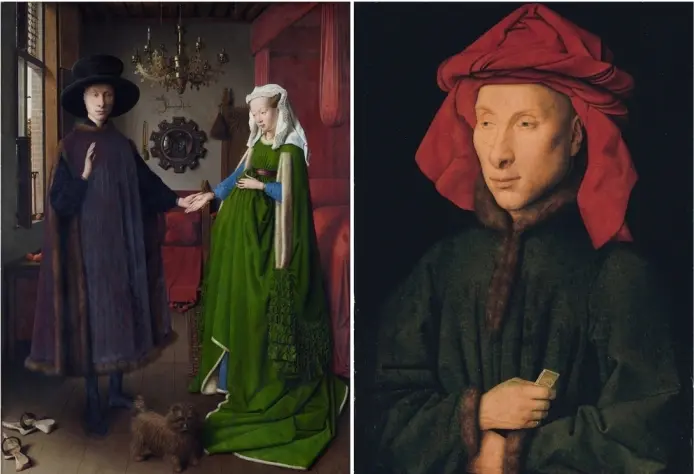Oil painting is known as the “king of the painting medium”, not only because of its thick pigment can be preserved for hundreds of years, but also because it can produce a variety of colors, especially plasticity. However, many beginners in the color mixing, often encounter “dirty color”, “gray surface”, “dry crack” these problems, in fact, it is not our hands are not clever, but the structure of the color wheel, material chemistry and layering principles are not well understood. It’s not that we are not good at it, but we don’t know much about the color wheel structure, material chemistry and layering principle. Today, Mr. Xiaosun will combine many authoritative resources, as well as museum restoration codes and teaching experience, to give you a good talk about how to mix oil paint.
Why is color mixing central to oil painting?
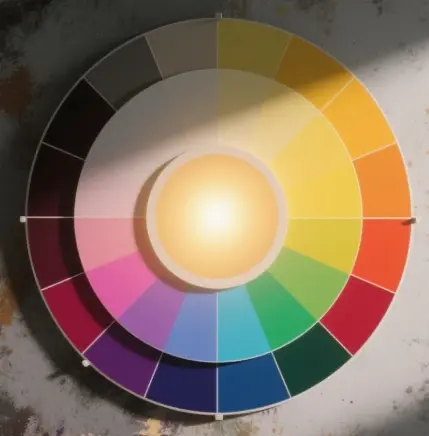
The slow drying properties and layering advantages of oil paints
The dry oils used for oil painting, like linseed oil and poppy oil, will slowly oxidize in the air and turn into a solid reticular film. This property allows us to have two different ways of creation, one is wet painting wet, and the other is layering overpainting. Because the pigment dries slowly, the colors have enough time to blend on the screen. But if the bottom layer of color is not blended properly, it will affect the top layer of color before it dries completely hard. That’s why accurate and stable color matching is especially important for layering colors one layer after another.
“Dirty Colors and Light Stability: The Cost of Color Mixing Mistakes
“Dirty color” is generally caused by three chemical reasons: first, the proportion of complementary colors is not controlled, the second is the opaque and transparent colors covered in the wrong order, and the third is too much solvent, so that the color powder distribution is not uniform. In addition to the color does not look good, mixing colors when adding too much white, but also reduce the light stability of pigments, that is, the color in the ultraviolet radiation is more likely to fade.
Three major benefits of systematically mastering color mixing for creative work
- Improve efficiency: By mixing the color formula in advance, you don’t have to try things out on the fly when you paint, and you save time waiting for the paint to dry.
- Maintaining stylistic consistency: By mixing colors in a uniform gray scale and saturation, a series of paintings put together will have coordinated colors.
- Reduce material waste: by mixing colors accurately, you won’t have a lot of paint that you can’t use up, and you’ll save on expensive professional-grade paints.
Preparation for color mixing: tools and materials
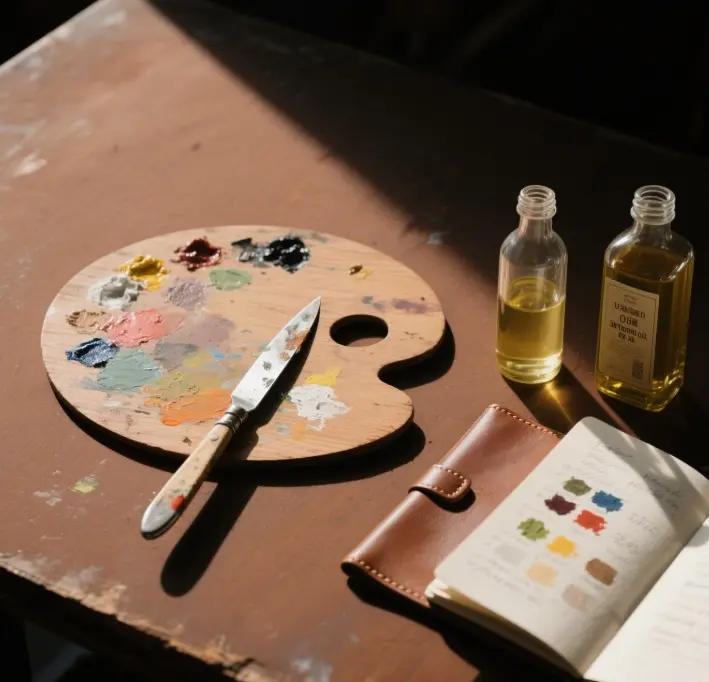
Palette Knife vs Paintbrush: Advantages and Disadvantages of Color Mixing Tools
The blade of a palette knife is very sharp, and it is easy to scrape the paint off after use, so that different paints won’t remain on the blade and contaminate the next color. Brushes can only be used to blend colors slightly in a small area, or to mix colors when painting wet. If you use a brush to mix colors over a large area, the bristles wear out quickly and you tend to mix dirty colors. So the general authority of the teaching are recommended, mixing colors with a palette knife, painting with a brush.
Palette choice: wood, glass, a torn paper comparison
| Quality | Pros | Cons | Scenarios |
| Wooden boards | Very light and comfortable to hold | Difficult to clean | Outdoor sketching, painting while standing for long periods of time |
| Glass | Easy to scrape clean, can judge the color depth objectively | Heavier | Indoor fixed working table |
| A torn paper | No need to clean, very time-saving | Opaque, easy to judge the color shade bias | Classroom, often do demonstrations |
Solvents and media: the role of linseed oil, OMS, Alkyd
- Odorless Mineral Oil (OMS): makes the pigment less viscous and more fluid, and does not leave traces after evaporation.
- Refined linseed oil: makes the pigment more glossy and transparent, suitable for overdyeing at a later stage in the painting.
- Alkyd Medium: It can make the pigment dry on the surface in 24 hours, which solves the problem of having to wait for a long time for one layer of painting. However, if you add too much, the brushstrokes of the pigment will become thin.
When mixing colors, the golden ratio of solvents, oils and pigments is 1:1:4, with a few adjustments depending on the weather and painting method.
Color Diary and Sample Cards: A Method for Recording Color Mixing Recipes
Cut small cards out of 300g oil paper and record on each card the formula of the pigment, the ratio of the medium, the drying time, and the change in color after 1 week of light exposure. Over time, you can build up your own color matching database. In the future, when encountering complex colors, look at the card can quickly mix the same color.
Color Wheel Basics and the Finite Palette
Primary and Secondary Colors: A Quick Look at the Structure of the Color Wheel
RYB Primary colors, that is, red, yellow, blue, two mixed to get orange, green, purple three secondary colors. Mixing the secondary colors with adjacent colors results in six intermediate colors. Knowing these 12 color divisions, we can quickly figure out the shortest way to turn one color into another.
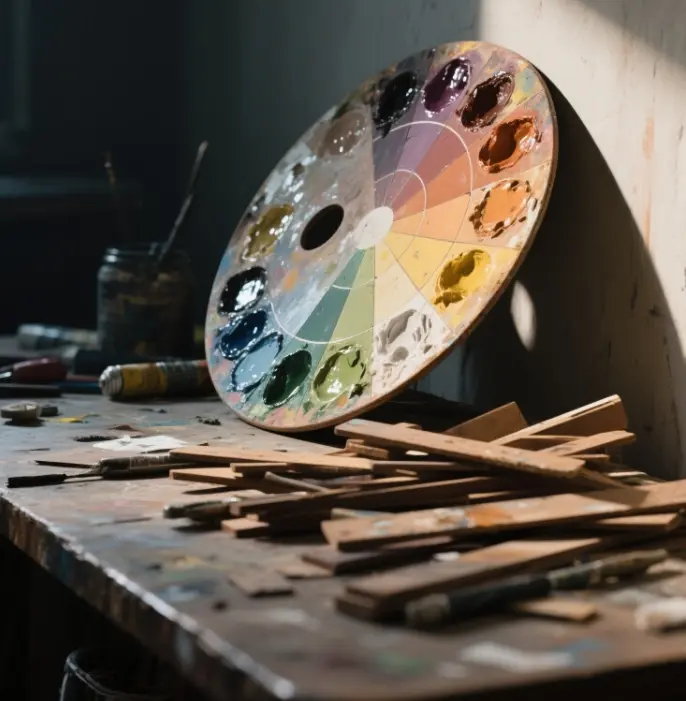
Warm/Cool Bias Determination
Even if the color has the same name, there may be a difference between warm and cool colors in different brands or batches. The way to judge is to compare the color you want to mix with the base color on the color wheel. If it is closer to yellow, it is a warm color; if it is closer to blue, it is a cool color. When mixing colors, putting colors with the same warm and cool tendencies together can make the colors more saturated; putting colors with different warm and cool tendencies together is easier to make gray tones.
Advantages and examples of a limited palette (3-7 colors)
- Three-color limit: with titanium white, phthalocyanine blue, red deep and cadmium yellow in the three colors, we can train our ability to fine-tune the color.
- Five-color classic: on the basis of three-color, with the addition of mature ochre and ivory black, we can adjust the gray scale more accurately.
- Morandi Seven Colors: Add yellow ochre and ultramarine and you’ll be able to mix the colors of most of life’s still lifes.
- Using a limited palette gives a more harmonious picture and doesn’t rely too much on the colors that are already in the tube.
Earth Colors: The Neutralizing Function of Ochre, Brown Earth and Yellow Earth
Most of the earth colors are natural iron oxides that are particularly light stable. Adding a little earth color to a color makes the complementary colors mix less abruptly and is a good way to quickly reduce the saturation of a color. Landscape painters often use yellow ochre and ultramarine to produce serene shadow colors like Paynes Gray.
12 Practical Tips for Mixing Colors (5 blueprints)
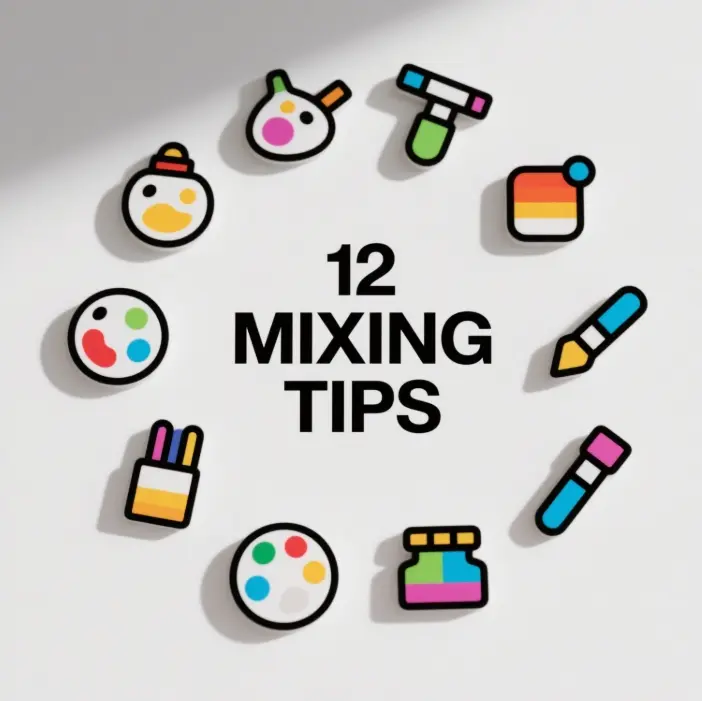
- Mixing colors from light to dark: Start with a white base and slowly add other colors so that you can more accurately control the brightness of the colors.
- Pre-tuning Color Strings: Divide the colors into 5 – 7 squares of lightness and arrange them in a series so that the tone of the colors will be consistent throughout the painting.
- Reduce Saturation with Complementary Colors, Not Black: Using complementary shades of color does not make the colors “dirty black” and gives the image a sense of light.
- Mix no more than 2-3 colors at a time: Mixing too many colors at once will make the colors more likely to become muddy.
- Transparent colors are added first, opaque colors are added later: this maintains the optical depth between color layers.
- Mixing with a palette knife: Mixing with a palette knife reduces the risk of contaminating the next color with residual pigment on the brush bristles.
- Test a small sample before putting it on the canvas: Paint a stroke on the edge of the canvas and wait for it to dry to see if there is any difference in the color before deciding whether or not you want to use that color.
- Stop adding white – correct brightness with a gray scale: adding too much white will reduce the saturation of the color, it is better to use a gray scale to adjust the brightness.
- Separate the brush from the blending area: It’s easier to keep the color pure by using a dedicated brush for the same color.
- Follow Fat – over – Lean: The top layer of color oil should be more than the bottom layer, which can avoid cracks in the picture.
- Eco-friendly solvents and ventilation: Keep the VOC below 500 ppm to protect our health.
- Continuously keep a color diary: Write down the situation of trying the color, the environment at that time, and the ratio of the medium, so that you will have a basis for mixing the same color next time.
Case Study: Color Mixing Strategies of Famous Artists
John Singer Sargent’s “stringing” of gray tones.
When Sargent painted portraits, he often used 4 – 5 strings of grays, from the darkest Paynes Gray to Titanium White with a cool gray. This ensures that the skin tone of the figure is in the same color spectrum as the background. The lips and ear tips are then painted in localized areas with very bright warm reds, which keeps the viewer’s attention focused on these areas.
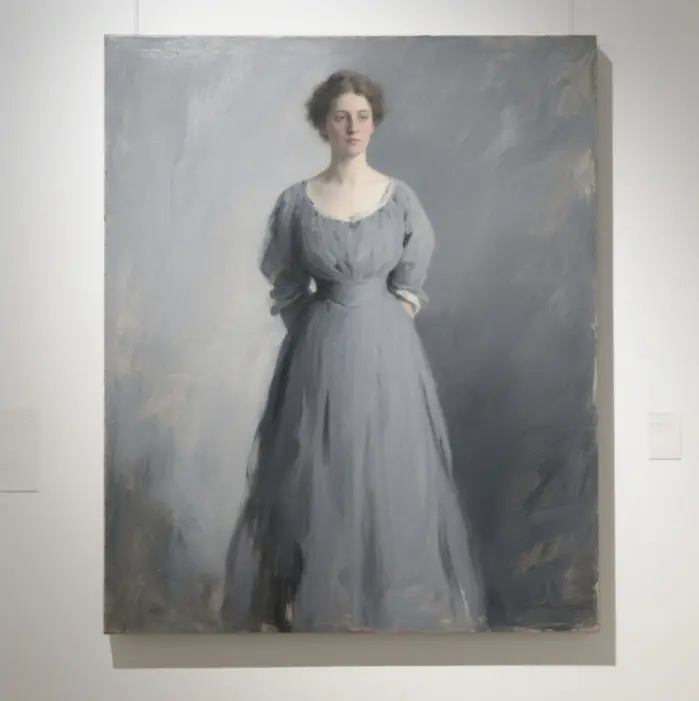
Morandi’s still life in high-gloss neutral gray
Instead of using almost pure black, Morandi uses ripe browns and ultramarines to bring out the darker colors, which makes the grays look more breathy. By letting the colors have a little change of warmth and coolness, he made the still life look especially peaceful and spacious, which is an example of “limited color palette” used especially well.
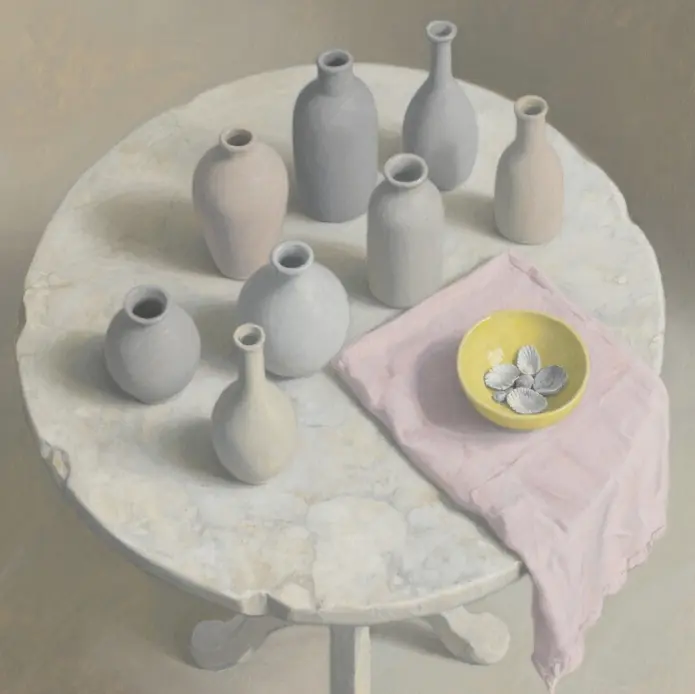
Complementary vibrations of light and color in Impressionist outdoor paintings
Monet and Renoir often put complementary colors together, rather than mixing them evenly. Such tiny brushstrokes create an optical mixing effect in our eyes. The brighter the light in the scene, the more contrasting the complementary colors are, and the more shimmering the image looks.
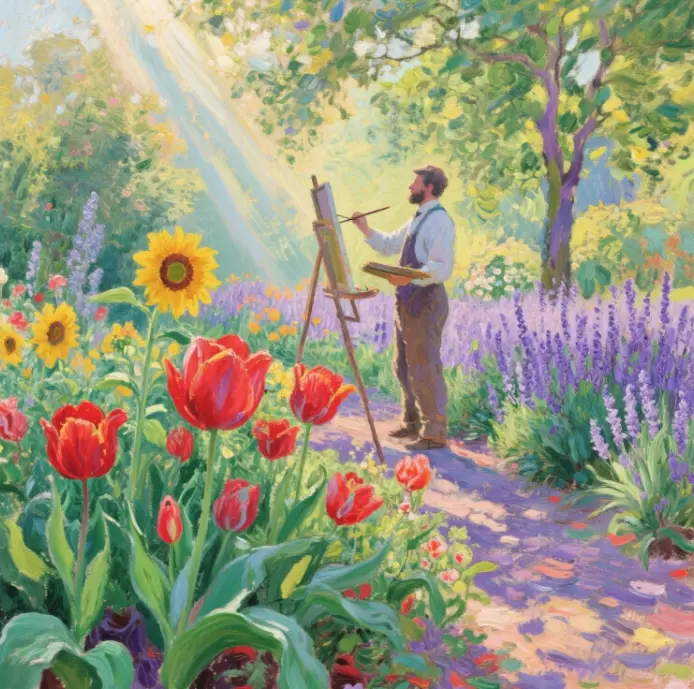
Common Mistakes and Corrections
- Mixing too many colors at once leads to turbidity → Use a palette knife to add colors little by little, and scrape the edge of the knife clean after each use.
- Blindly using black to deepen the color causes the picture to lose its vibrancy → Use complementary colors or deep earth colors to reduce the saturation of the color.
- Neglecting the proportion of oil causes dryness and cracking → Add at least 10% more oil for each new layer of color, or use Alkyd to balance it.
- Fogging of color layers due to solvent abuse → Use solvents in small amounts only on the bottom layer, and the higher you go, the more oils you use.
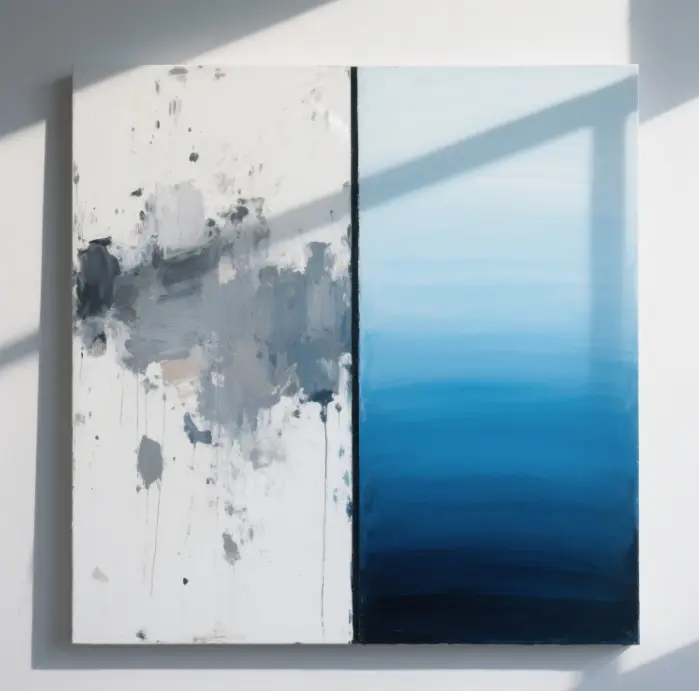
FAQ: The most concerned color mixing questions for newbies
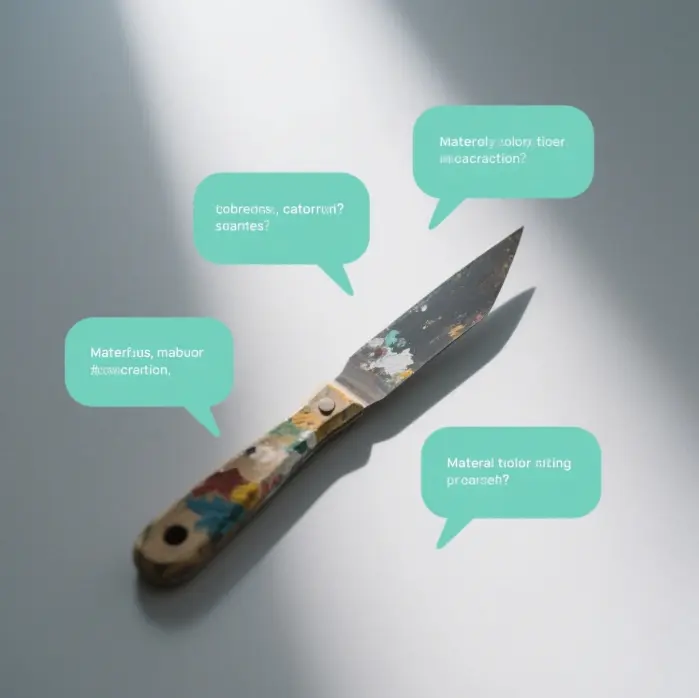
Q: How can I make shadows richer instead of pure black?
A: Mix with complementary colors, for example with Ultramarine and Burnt Ochre you can make a warm grayish purple. Then layer a little more gray of the object’s own color around the edges of the shadows, which ensures that the shapes and colors of the shadows are consistent.
Q: Why are my skin tones always gray?
A: The key to a good skin tone is “gray with red”. First use titanium white, ripe ochre and ultramarine to make a cold gray tone, and then add a little cadmium red or yellow ochre to control the color of the warm and cold. The important thing is to reduce the saturation of the color first, and then adjust the hue of the color.
Q: Can I mix different brands of pigments?
A: Most modern brands of pigments can be mixed and used together, but be aware that the oil content of transparent colors may be different. It is recommended to try the colors on the swatch first and wait for 7 days to see if the colors will stratify or bleed.
Q: Will fast drying mediums affect color purity?
A: Standard Alkyd is very transparent and has very little effect on color. However, if you add more than 20% at a time, the risk of drying and cracking will increase. It is safer to keep it at about 10%.
Advanced Resources and Practice Paths
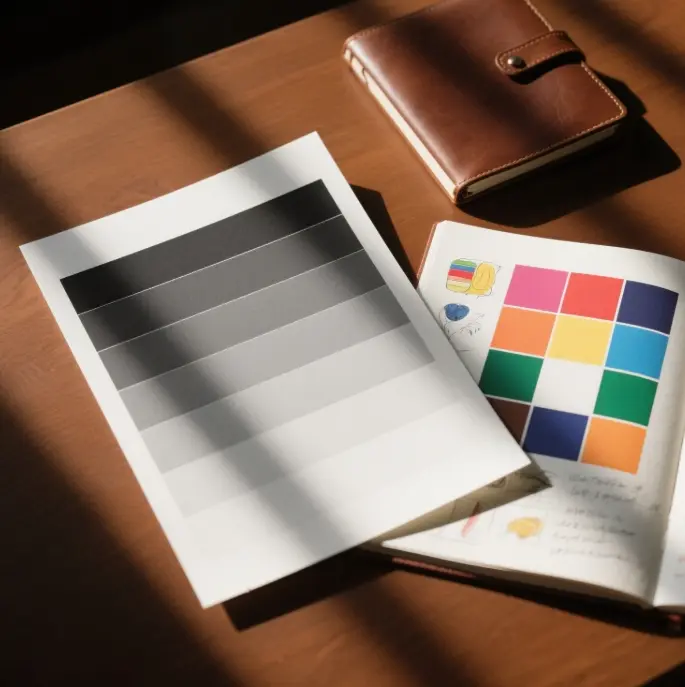
Recommended Exercises
- Complementary Grayscale Strips: Slowly mix complementary colors in 9 squares to train our ability to control color saturation.
- Experimenting with monochromatic bases: Use a raw brown or green base color to see how it affects the overall color of a later painting.
- Five-stroke limited practice: only five strokes for each color, which can train our ability to anticipate the color and make decisive strokes.
Online Courses and Books
- Color and Light (James Gurney) – teaches us visual logic and control of grayscale.
- Oil Painting Techniques and Materials (Michael Jacobs) — A systematic introduction to oil painting materials.
- New Masters Academy Color Matching Special: The instructor will demonstrate the whole process of oil painting color mixing step by step.
Long Term Enhancement Program
- Quarterly review of your color diary to compile common color formulas.
- Make your own “personal color chart” every six months, labeling the batches of pigments and the results of light tests.
- Every year, choose a new theme, such as thick paint, overdye, knife painting, and focus on the attack, so that our techniques and picture effects can be more rich.




